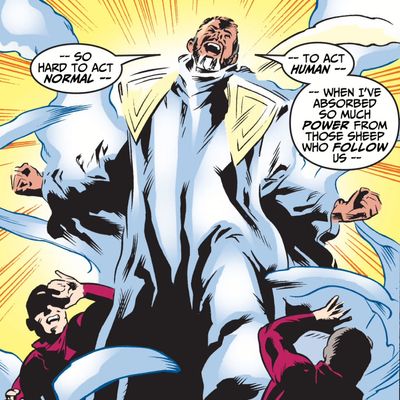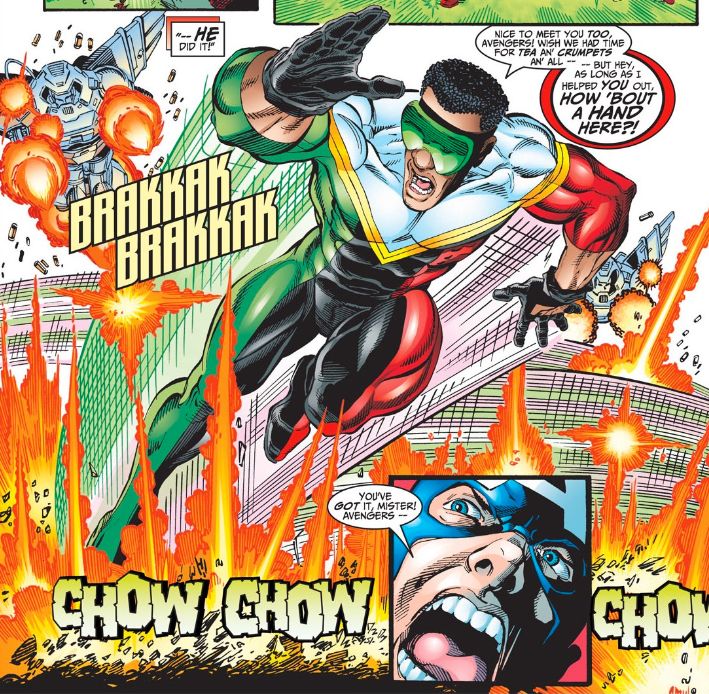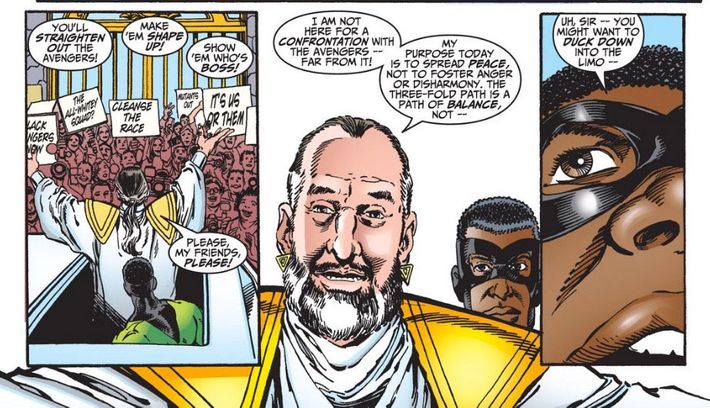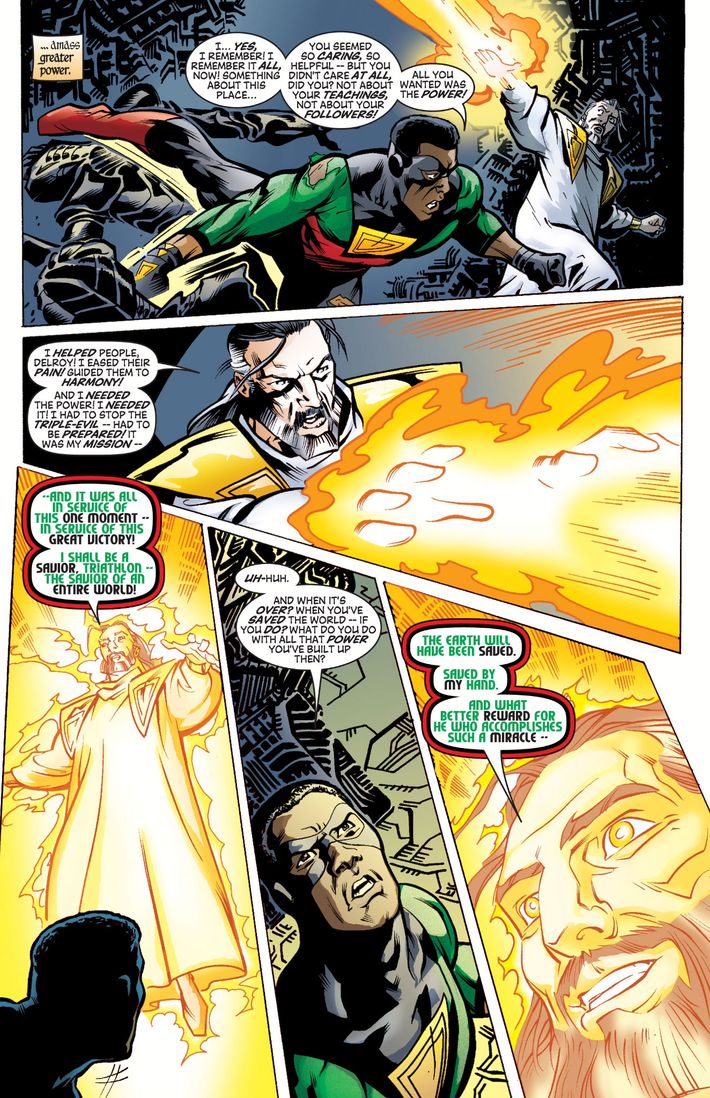
The turn of the millennium was a weird period for superhero comics; an era when financial desperation opened a path for wild experimentation. Marvel Comics was particularly hard hit, plunging into bankruptcy and emerging as a wounded giant. The company welcomed bold, weird ideas: Punisher became a zombie, Spider-Man and the X-Men got rebooted series where they were all angsty teens again, and  a Scientologist joined the Avengers. And then the Avengers teamed up with the evil super-powered leader of Scientology. And they all flew in a spaceship powered by the souls of Scientologists. And they fought a giant alien pyramid.
Okay, letÔÇÖs take a step back. Technically, the religion in question wasnÔÇÖt the Church of Scientology; it was an extremely thinly veiled stand-in for it called the Triune Understanding. The story line about it was the brainchild of Avengers writer Kurt Busiek (who fully admits to the Triune UnderstandingÔÇÖs status as a Scientology pastiche), that story line ran for an astounding four years, and ÔÇö perhaps most remarkable of all ÔÇö this bizarre narrative thread was oddly tender and empathic toward Scientologists. In honor of the current barrage of criticism lobbed at Scientology in the wake of the documentary Going Clear, let us revisit this strange chapter in superhero history.
Busiek knew next-to-nothing about Scientology when he got the Avengers gig in 1998. ÔÇ£IÔÇÖd read stuff from old-line SF writers whoÔÇÖd been around when [Scientology founder L. Ron] Hubbard decided to create it, so I had a grounding in at least their view on it being a cynical creationÔÇØ he told me. Nevertheless, he thought a ÔÇ£Scientology-like organizationÔÇØ would make for a fun story element and moved ahead without much information. ÔÇ£IÔÇÖd read various expos├®-type articles about the modern state of the organization. But I didnÔÇÖt do any research beyond that, because I wasnÔÇÖt trying to do an expos├® myself. I just wanted to take the idea of a corrupt pop-psych religion and use it as story fodder.ÔÇØ
Thus, in Avengers No. 8 (the series had just been rebooted with a new No. 1 issue), a mysterious new superhero appeared and the Triune tale began. The previously unseen superhuman abruptly shows up during a battle at JFK Airport, saving the AvengersÔÇÖ butts and ÔÇö in between kicks and punches ÔÇö he introduces himself thusly: ÔÇ£The nameÔÇÖs Triathlon ÔÇö and IÔÇÖm three times as strong, fast and agile as an ordinary human!ÔÇØ

As far as superhero boasts go, that one  wasnt all that thrilling. But in the next few issues, we found out Triathlons appeal wasnt his power set: It was his beliefs. As it turned out, Triathlons name was surprisingly literal: He had once been a successful track star named Delroy Garrett Jr. He scored gold medals at the Olympics, only to get busted for using steroids. His life shattered, the fallen athlete wandered the streets of Philadelphia until he stumbled across a local chapter of the Triune Understanding.
ÔÇ£TheyÔÇÖre kind of, I dunno ÔÇö a way of thinking, or maybe a church,ÔÇØ Garrett tells Hawkeye while the two of them crawl through an air vent to fight some baddies in Avengers No. 9. ÔÇ£I didnÔÇÖt believe in what they had to say at first ÔÇö but they showed me a way to find peace, to let go of the anger I had toward myself ÔÇö and in time ÔÇö a way to unlock the power within me.ÔÇØ Through an unexplained method, the Triunes gave him superpowers. The belief system he found there was pretty vague, but centered around finding balance between various triads in your life: mind, body, and spirit; head, heart, and hands; past, present, and future; and so on.
Busiek wasnÔÇÖt a Scientology expert, but he was presenting a reasonably common path toward HubbardÔÇÖs real-life church: wayward celebrity struggling with substance abuse gets roped in with promises of realizing his buried potential. (Hell, you donÔÇÖt even have to take out the superpowers part: Tom Cruise apparently thinks Scientology has made him superhuman.) Although the Avengers were taken aback by TriathlonÔÇÖs audacious explosion into their lives, he proved himself to be a decent dude. As it turned out, the AvengersÔÇÖ liaison with the U.S. government was also a member, and he was a nice guy who posed no threat. So far, it didnÔÇÖt seem like EarthÔÇÖs mightiest heroes would have any trouble with this quasi-Scientological movement.
Nevertheless, readers soon got reason to raise their hackles. When we finally see other Triunes in issue 15, theyre at a massive get-together in Texas and theyre addressed by their leader, a flashily dressed gent named Jonathan Tremont, who sports suspiciously expensive jewelry and a ridiculous salt-and-pepper beard. (David Miscavige, he was not.) When the Avengers stop by Triune HQ to investigate a nearby supervillain sighting, Tremont watches them on a screen, strokes his whiskers, and muses to an assistant, Hm? Oh, I wouldnt worry about it, Teodor. It will be  taken care of  By issues end, we see him privately communing with a cosmic baddie named Lord Templar. They chat about how the Understanding needs to sow suspicion of traditional authority structures and, accordingly, Templar advises Tremont to deploy a common Scientological tactic: discrediting people in the media. In this case, the Suppressive Persons were the Avengers.

This is where the Triune plot gets uncomfortable. In secret, Tremont launches a whisper campaign accusing the Avengers of not having enough nonwhite members, leading to hate mail and protests outside Avengers Mansion. (Protesters in issue 24 carry signs with truly delightful slogans, such as ÔÇ£ÔÇÿOF COLORÔÇÖ DOESNÔÇÖT MEAN RED PLASTICÔÇØ and ÔÇ£SEND ÔÇÿEM BACK TO SCANDINAVIA WHERE THEY COME FROM.ÔÇØ) And after Tremont frames some Avengers back-benchers for the destruction of Triune property, the media starts wondering if the team is religiously bigoted, too. The aforementioned government liaison issues an ultimatum: Prove youÔÇÖre not prejudiced by recruiting Triathlon ÔÇö heÔÇÖs an African-American Triune, after all ÔÇö or risk arrest. Garrett doesnÔÇÖt like the idea of being an affirmative-action hire, but says heÔÇÖll join ÔÇ£for one reason and one reason only. IÔÇÖm going to prove youÔÇÖre wrong ÔÇö wrong about me, wrong about the Triunes ÔÇö and then IÔÇÖm going to rub your noses in it!ÔÇØ
For the next few years, Triathlon was a member of the Avengers lineup. He wasnÔÇÖt terribly thrilling as an action hero, to be honest. He was just a nice guy who was good at fighting and who would occasionally muse on the difficulties of being a person of color in a white environment. The Understanding, as an organization, didnÔÇÖt show up for a long while.
But hoo boy, when it did reappear, things got really weird ÔÇö and theoretically quite insensitive toward Scientology. In Avengers Annual 2001, we find out that B-list heroes Justice and Firestar went undercover as Triunes. While there, they discovered that the religion is preparing to fight some kind of ÔÇ£giant threat from spaceÔÇØ and, as part of that effort, theyÔÇÖve built a massive spaceship. ÔÇ£IÔÇÖve seen the plans,ÔÇØ Firestar says. ÔÇ£ItÔÇÖs supposed to be powered by the spirits of the acolytes. By their belief.ÔÇØ In other words, itÔÇÖs a Thetan-powered spacecraft.
Sure enough, a few issues later, some Avengers whoÔÇÖve been marooned in outer space get picked up by that Triune starship, where a robed Tremont tells them theyÔÇÖre on their way to fight what could be ÔÇ£the greatest danger Earth has ever facedÔÇØ: something called the Triple Evil. ÔÇ£Its coming has been foretold, and it must be stopped,ÔÇØ Tremont tells the heroes. ÔÇ£That is the one and only reason the Triune Understanding was created.ÔÇØ In a loose adaptation of ScientologyÔÇÖs alleged teachings about how humans are players in an interstellar battle between good and evil, we learn that Tremont stumbled across an alien artifact that gave him knowledge of the Triple EvilÔÇÖs millennia-old history. (Through means that are too complicated to get into here, Tremont also was able to grant superpowers to Garrett and ally himself with some Avengers villains.)

But when Tremont and the Avengers come upon that Triple Evil ÔÇö which is, for some reason, a giant pyramid piloted by aliens ÔÇö Tremont shows his true colors. Although he intends to use the souls of his followers to defeat the extraterrestrial threat, he plans to keep that power and conquer Earth himself afterward. Long story short: Triathlon beats the Triple Evil and de-powers Tremont. The day saved, they all return to Earth. Garrett is disappointed, but ÔÇö in a sweetly sympathetic twist ÔÇö ultimately doesnÔÇÖt demonize the Triunes. He finds out that the organization is trying to reorganize after TremontÔÇÖs fall from grace, and although he doesnÔÇÖt plan to return to the fold, he muses that ÔÇ£theyÔÇÖve done a lot of good, even if their leadership was corrupt.ÔÇØ
And that, for the most part, was that. Busiek left Avengers and we havenÔÇÖt seen much of the Marvel universeÔÇÖs answer to Scientology since then. Triathlon has popped up a few times, but the religious subplot has gone the way of the Dodo. ItÔÇÖs not surprising, given that fan response to the Triune narrative had never been all that positive. ÔÇ£Overall, people didnÔÇÖt seem to like the story, but mainly because of the racism and prejudice angles,ÔÇØ Busiek said. But the most surprising part of the storyÔÇÖs reception is the fact that the Church of Scientology ÔÇö so infamously litigious and willing to attack anyone who critiques them ÔÇö didnÔÇÖt raise a peep. Busiek recalls no complaints from the organization, nor its adherents: ÔÇ£Readers seem to feel there was no problem doing a Scientology-like villain-group.ÔÇØ Accordingly, his bosses at Marvel didnÔÇÖt offer any resistance to the story (ÔÇ£Not a lot of encouragement, either,ÔÇØ he recalled).
ItÔÇÖs near-impossible to imagine Marvel doing anything like this story today. When Busiek invented the Triune Understanding, American culture had largely left Marvel Comics by the wayside, and anything that happened to the Avengers was invisible to all but a few thousand dedicated readers. Now, nearly 15 years later, Marvel is at the forefront of American ÔÇö and global ÔÇö entertainment, thanks to its mega-successful Avengers film franchise. Although Marvel EntertainmentÔÇÖs comics arm only accounts for a fraction of its revenue, every creative decision goes through a fine filter of scrutiny and its comic story lines are regularly in the headlines (usually while being praised for greater inclusion of female and nonwhite characters). No company owned by Disney would dare take pot-shots, however veiled, at Scientologists in 2015. So even though the AvengersÔÇÖ struggle with faux Scientology wasnÔÇÖt a hit with fans, it stands as a fascinating artifact of a time ÔÇö not so long ago ÔÇö when Marvel was so unpopular that it could afford to get this weird.

